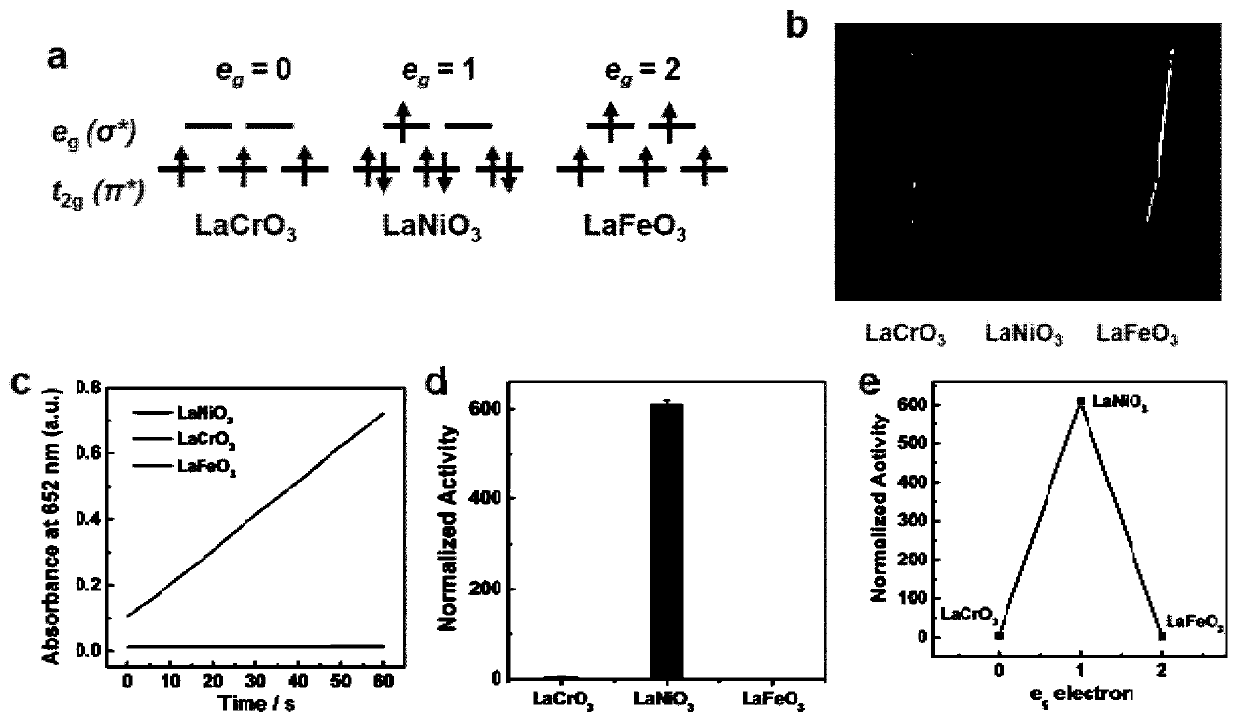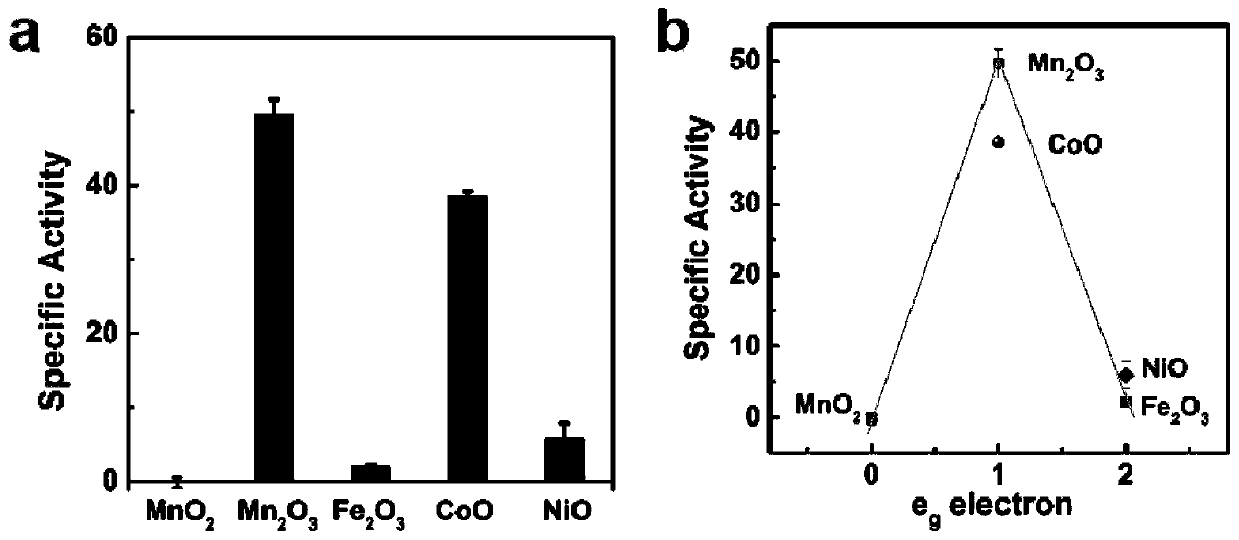High-activity nano-enzymes based on transition metal oxides and derivatives of transition metal oxides as well as acquisition method and application of high-activity nano-enzymes
A transition metal and transition metal ion technology, applied in the cross field, can solve the problems of low catalytic activity of nanozymes, slow nanozyme research and application, and catalytic reaction specificity not as good as natural enzymes, etc. To achieve the effect of flexible control
- Summary
- Abstract
- Description
- Claims
- Application Information
AI Technical Summary
Problems solved by technology
Method used
Image
Examples
Embodiment 1
[0042] Embodiment 1 perovskite type transition metal oxide catalytic activity and e g Electron number correlation yields highly active perovskite-type transition metal oxide nanozymes
[0043] 1) ABOs 3-δ Preparation of type perovskite transition metal oxide nanomaterials:
[0044] ABOs 3-δ The preparation methods of type perovskite transition metal oxides and their doped nanomaterials are all sol-gel methods. Specifically, 1.5 mmol of lanthanum nitrate hexahydrate, 1.5 mmol of nickel nitrate hexahydrate (chromium nitrate nonahydrate or iron nitrate nonahydrate), and 12 mmol of citric acid were uniformly dispersed in 200 mL of water. After the solution was fully stirred and mixed, 1.5mL of ethylene glycol was added, and the stirring was continued. The solution was heated to 90°C until the solution became a viscous gel-like liquid. Put the gel into an oven and heat at 180°C for 5 hours to obtain a solid perovskite precursor. Put the perovskite precursor into a calciner at...
Embodiment 2
[0049] Embodiment 2 flexibly adjusts e by doping g The number of electrons and its nanozyme activity obtained highly active La 0.5 Sr 0.5 FeO 3-δ , SrFeO 3-δ
[0050] 1) LaFeO 3-δ , La 0.5 Sr 0.5 FeO 3-δ , SrFeO 3-δ The preparation is also synthesized with reference to the method in Example 1).
[0051] 2) Prepare substrate solution for measuring peroxidase mimic activity: sodium acetate buffer (pH 4-5, 810 μL), 500 mM H 2 o 2 (100 μL), 10 mM TMB (80 μL).
[0052] 3) Preparation of nanozyme solution: the concentration of all transition metal oxide nanozymes was 1 mg / mL, and they were uniformly dispersed in water by ultrasound.
[0053] 4) Determination of peroxidase mimetic activity: Take 10 μL of the above-mentioned nanozyme solution and add it to 990 μL of the substrate solution. The reaction temperature is 40°C. Reaction rates were calculated from the change in absorbance over 60 seconds.
[0054] Depend on figure 2 It can be seen that due to the LaFeO 3-δ ...
Embodiment 3 2
[0055] The acquisition of embodiment 3 binary metal oxide nanozymes
[0056] 1) Preparation of binary metal oxide nanomaterials:
[0057] MnO 2 : About 2g KMnO 4 with about 0.8g MnSO 4 ·H 2 O was added to about 25mL of water, mixed and stirred evenly, then placed in a high-pressure reactor at 150-180°C for 10-15 hours, centrifuged to obtain the product, washed with water several times, and then dried.
[0058] mn 2 o 3 : About 0.5g KMnO 4 Mix with about 0.6g of glucose in about 10mL of water, stir evenly and put it into a high-pressure reactor at 150-180°C for 8-12 hours. The obtained product is centrifuged, washed and dried, and finally calcined at 500-600°C for 4-6 hours to obtain the final product .
[0059] CoO: About 0.1g CoSO 4 ·7H 2 O and about 0.3g urea were dissolved in the mixture of ethanol and water, stirred evenly, added ammonia water drop by drop, after stirring for 30 minutes, placed in a high-pressure reactor at 120-150°C for 10-12 hours, and the obta...
PUM
 Login to View More
Login to View More Abstract
Description
Claims
Application Information
 Login to View More
Login to View More - R&D
- Intellectual Property
- Life Sciences
- Materials
- Tech Scout
- Unparalleled Data Quality
- Higher Quality Content
- 60% Fewer Hallucinations
Browse by: Latest US Patents, China's latest patents, Technical Efficacy Thesaurus, Application Domain, Technology Topic, Popular Technical Reports.
© 2025 PatSnap. All rights reserved.Legal|Privacy policy|Modern Slavery Act Transparency Statement|Sitemap|About US| Contact US: help@patsnap.com



